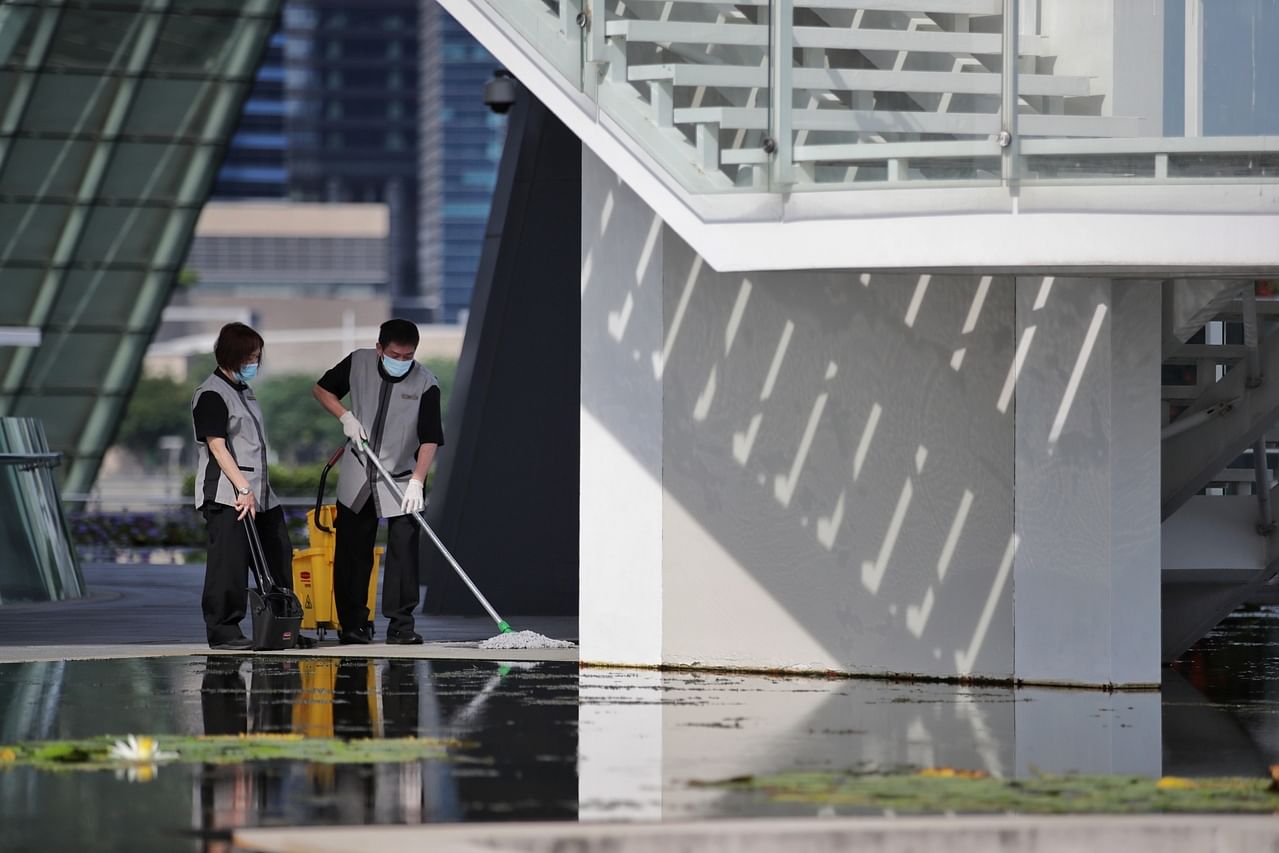S'pore's wages at bottom-fifth grew at faster rate than median from 2009 to 2019
Sign up now: Get ST's newsletters delivered to your inbox

The PWM is currently mandatory in the cleaning, security and landscape maintenance sectors.
PHOTO: ST FILE
Charmaine Ng
Follow topic:
SINGAPORE - The real wages of Singaporean and permanent resident lower-wage workers at the 20th percentile grew 39 per cent between 2009 and 2019, faster than that of workers at the median at 33 per cent.
And while the Covid-19 pandemic has had an impact on these lower-wage workers last year, government schemes have helped to mitigate the impact and bring their wages to the 2019 pre-pandemic levels, said Senior Minister of State for Manpower Zaqy Mohamad in Parliament on Tuesday (July 6).
This was a result of policies such as the Progressive Wage Model (PWM) and Workfare to support lower-wage workers, he added. "This has allowed our lower-wage workers to gain ground and progress faster than the median."
He was responding to more than a dozen questions filed by MPs from the People's Action Party and the Workers' Party on the PWM.
Mr Zaqy noted that while lower-wage workers in Singapore have seen "robust real income growth", this was not the case for most Organisation for Economic Co-operation and Development countries.
"For example, over the same 10-year period, workers at the 20th percentile in the UK saw no real wage growth, while those in Japan and US saw only cumulative real wage growth of 3 per cent and 6 per cent respectively, despite having minimum wage," he said. "Nonetheless, we should not take our progress for granted. It is not inevitable that this will always be so."
The PWM is a wage ladder that sets out the minimum pay and training requirements for lower-wage workers at different skill levels in various sectors.
It is currently mandatory in the cleaning, security and landscape maintenance sectors, and covers about 85,000 workers.
Discussions are in progress to implement the PWM in the food services, retail and waste management industries, as well as to expand coverage to include in-house cleaning, security and landscaping workers.
These moves will more than double the PWM coverage to up to 218,000 workers, said Mr Zaqy.
Lower-wage workers also receive a monthly supplement to their income through the Workfare scheme, which is designed to encourage them to work regularly rather than rely on welfare measures, said Mr Zaqy.
"Studies have shown that Workfare has led to an increase in employment rates, with the highest increases among older workers," he said.
Since Workfare was introduced in 2007, nearly a million lower-wage workers have received close to $7.8 billion in payouts, said Mr Zaqy.
Another $600 million has been paid out to employers and workers through the Workfare Skills Support scheme, which supports lower-wage workers to upskill themselves.
When the Covid-19 pandemic started last year, the Workfare Income Supplement and one-off Workfare Special Payment of $3,000 helped to cushion the decline in wages for lower-wage workers, said Mr Zaqy.
"After taking this into account, the incomes of the first 20 per cent of income earners in 2020 were actually similar to wages in 2019," he said.
The Government's fundamental objective is to ensure that the society takes care of every worker, said Mr Zaqy.
"We cannot progress as a society and achieve economic progress with a strong social compact and national identity, if there is a group of workers who are left behind," he said. "We must ensure that every worker who is prepared to work hard will be able to earn fair wages and prosper along with the rest of Singapore."

Policies such as the Progressive Wage Model (PWM) and Workfare to support lower-wage workers has allowed them gain ground and progress faster than the median, said Minister of State for Manpower Zaqy Mohamad.
PHOTO: GOV.SG
With the Covid-19 pandemic still raging on, it is timely that efforts are taken now to strengthen their prospects and progression for the long term, said Mr Zaqy.
This is why the Tripartite Workgroup on Lower-Wage Workers was formed last year, and will be releasing its recommendations "in the coming months".
Compared with 2012 when the PWM for cleaning was first introduced, attitudes of employers and service buyers have changed, said Mr Zaqy.
"Today, all PWM stakeholders buy into the same vision, and work together to support our lower-wage workers. Employers now understand the benefits of PWM to them and their workers," he added.
This is why the cleaning sector was able to recently agree to "a much more ambitious rate of wage growth" for workers, said Mr Zaqy.
Last month, the Government accepted recommendations by a tripartite committee on the cleaning wage ladder to raise minimum wages of cleaners from 2023 to 2028. The first adjustment in 2023 will see base wages of general and indoor cleaners increase by almost 20 per cent to $1,570, from $1,312 in 2022.
This was achieved through negotiations between the unions, employers and service buyers to find common ground, said Mr Zaqy.
He added that the "negotiated approach of the PWM helps address concerns and allows the sector to raise wages at a pace suitable for them".
This approach also allows the industry stakeholders to plan ahead and account for the PWM wage increases in their multi-year contracts, and a midpoint review by the tripartite committee ensures that the wage increases remain sustainable, said Mr Zaqy.
He added that the Covid-19 pandemic has shown that the PWM approach is "superior to a blunt minimum wage".
"A blunt minimum wage may not have been able to achieve consensus or as ambitious a wage growth. Sectors such as tourism, aviation, hospitality and others that are severely impacted would not have been able to agree to such a move," said Mr Zaqy.
"Our targeted approach enables the tripartite movement to advance PWM at a pace depending on how the different sectors perform in the market."

